
Mango Languages is a fun, interactive online program for learning foreign languages in a conversational style. Mango Homeschool Edition is a yearly subscription allowing you unlimited access to as many of the 60+ languages offered by Mango Languages as you choose. In other words, you pay one yearly fee, which varies depending upon the number of students in your homeschool, and you get total access to as many languages as you want! The program works for ages 6 through adult, so anyone in the family can learn a new language with Mango. My family has been reviewing the beta version of the Mango Homeschool Edition for the past several weeks, and I am happy to share our review with you.
Cost of The Program
Mango Homeschool Edition’s introductory pricing is as follows:
- 1 subscription is $18/month or $125/year total
- 2 subscriptions is $28/month or $175 /year total
- 3 subscriptions is $38/month or $225/year total
- 4 subscriptions is $48/month or $275/year total
- 5 subscriptions is $58/month or $325/year total
- 6 or more subscriptions is a special group rate that will depend on the number in the group
Program Features
The Mango Homeschool Edition currently includes the following features:
- Over 60 different languages
- Progress Assessments
- Built-in journals, discussions and wikis
- Collaborative learning spaces
- eNote messaging /chat rooms
- Access to embedded/downloadable content
- Support from other community members
- Calendars to schedule meetings or study groups
In addition, Mango Homeschool Edition will be adding the following features over the next several months:
- Enhanced Tracking and Progress Monitoring – including seat time (for students and parents)
- Goals and Personal Lesson Plans (both stand-alone and tied into Mango courses)
- Resume and Portfolio Builder
How the Program Works
The first, and certainly the only difficult part of using Mango, is simply choosing a language! Mango has a huge course directory full of different languages to choose from, many of which are very difficult to find elsewhere. You can find everything from Latin, Greek, and Biblical Hebrew, to Spanish, French, and German, plus hard-to-find languages like Hawaiian, Bengali, and Kazakh, just to name a few! The great thing, though, is that with Mango Homeschool Edition, each student can not only choose which language that he wants, but as many as he wants as well.
Once a language has been chosen, the student is taken to the language’s landing page, and from there can then log into the Mango system. Each lesson is presented on a series of flash cards, which the student clicks to flip through. When the student logs in and is taken to the first lesson, the first card then explains the conversational and grammar goals of the lesson.
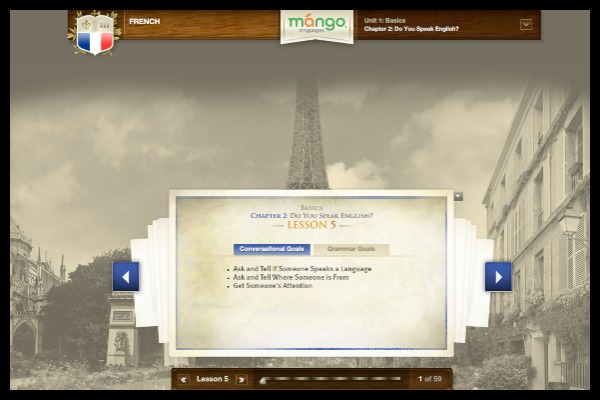
The second card gives a conversation, which serves as an overview of the phrases to be learned in the lesson. First presented in English, the student reads along as the conversation is translated and spoken for them line by line. At any time, students can hover over each line of dialog in order to see it translated back into English. Once the conversation is complete, students can click the play button next to each line to hear it spoken individually, or hit the replay button to listen to the complete conversation again.
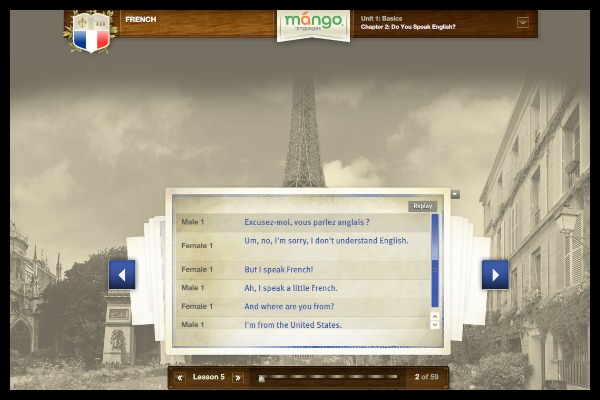
From there, the conversation is broken down into its components, which are presented on the remaining flash cards. Some cards present words and phrases from the beginning conversation. The phrase cards are color coded to make translating individual words very easy. Students can also hover over each word on these cards to pop up a pronunciation helper. On both the phrase and individual word cards, the microphone icon allows students to compare their own pronunciation with the program’s to ensure that they are speaking properly.
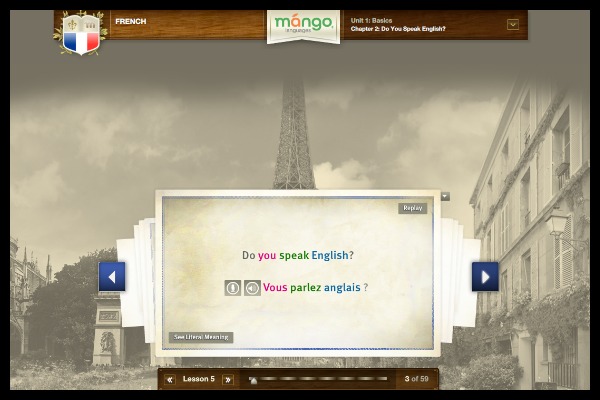
Other cards scattered throughout the lesson present grammar or culture notes that provide students with further explanation of differences between the language studied and English language rules.
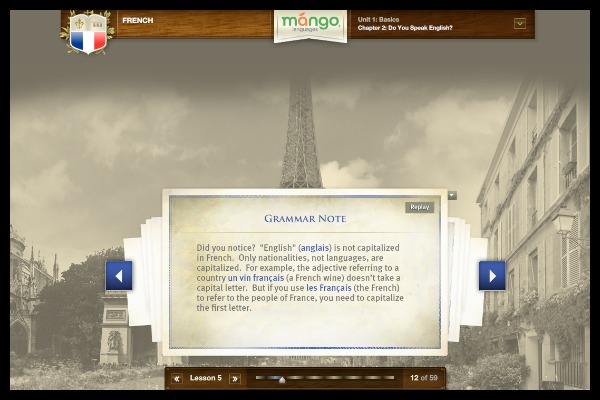
The remainder of the lesson flash cards ask students to translate a word or phrase presented by previous cards. On each card, the student is given a time clock that gives them a set amount of time to respond. At the end of that time, or if the student clicks “show the answer”, the proper translation is given so that the student can check to be sure that they responded with the correct phrase.
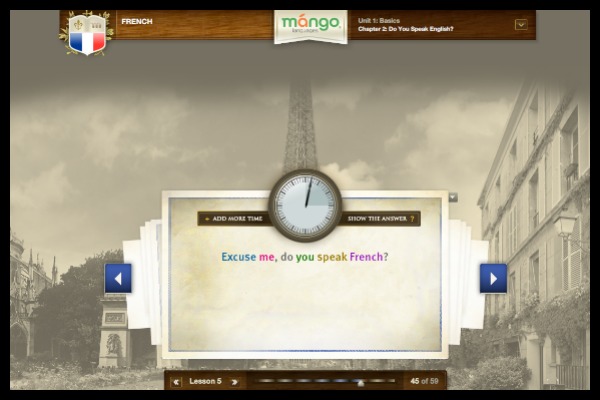
How We Used Mango
For our review period, we chose to try out European French. Because we were not completing a foreign language for credit, but rather for enrichment, I allowed both my boys to choose how far they would go each day with the course. On average, they were able to complete a lesson approximately every other day, beginning a new lesson the first day, and using the next day to review the same lesson before moving on. I think that by taking at least 2 days per lesson, they were able to retain the information more easily. The Mango website is easy enough to navigate that my boys were able to log into the program on their own, giving them a bit of independence in handling their own course.
In the files section of many of the languages, there is a written copy of each lesson that can be printed to use for further practice. We definitely took advantage of that feature, and even made some flash cards based off of the printouts so that my boys could study together. There are optional quizzes at the end of each lesson, which my boys also completed. I think that the printouts were especially useful as study sheets for upcoming quizzes. Quizzes can be retaken if needed, so on one occasion when one of my sons was unhappy with a quiz score, he was able to go back to review the material and then retake the quiz in order to improve his score. This feature helped keep my boys motivated to learn, rather than feeling defeated with a less-than-perfect grade.
Our Opinions of the Program
My boys really had a fun time with the program. They used it individually for the most part, but sometimes had fun doing lessons together, correcting each others’ pronunciation and competing to see who could complete translations faster. The boys loved the fact that Mango made it very easy to set their own pace. They never felt pressured to complete assignments by a certain deadline, which helped them relax and enjoy the learning process. I believe that Mango Homeschool Edition has been a very effective program. I often hear my sons greeting each other in French, and they are eager to share their new phrases with family and friends. My only wish is that there were more written exercises to go along with this program. We did make our own flash cards, but it would be nice to have some written work built into Mango somehow. All in all, though, I think Mango Homeschool Edition is an excellent program for learning a new language. I think, for the unlimited access to so many languages, and the unique and fun way that the lessons are presented, this program is a tremendous value.
More Information About Mango
You can learn more about this program on the Mango Languages Homeschool Edition website. You can also keep up with Mango through their social media links below.
- Twitter: https://twitter.com/MangoLanguages
- Pinterest: http://www.pinterest.com/mangolanguages/
- Facebook: https://www.facebook.com/MangoLanguages


















An excellent review! We too determined that doing a lesson one day and a review of the lesson the next worked the best for us.
Thanks so much for your helpful review! 🙂 Our homeschooling family used Mango (not the homeschool version) this last school year through an inexpensive rate with a local tiny private school, and Mango Languages has worked really well for us! Combining that with a tutor once a week for my daughter to speak Spanish in conversation has been a great mix at the high school level. Thanks.
Thanks so much for reading our review. I’m glad to hear that Mango has worked so well for you! We have really enjoyed it. 🙂